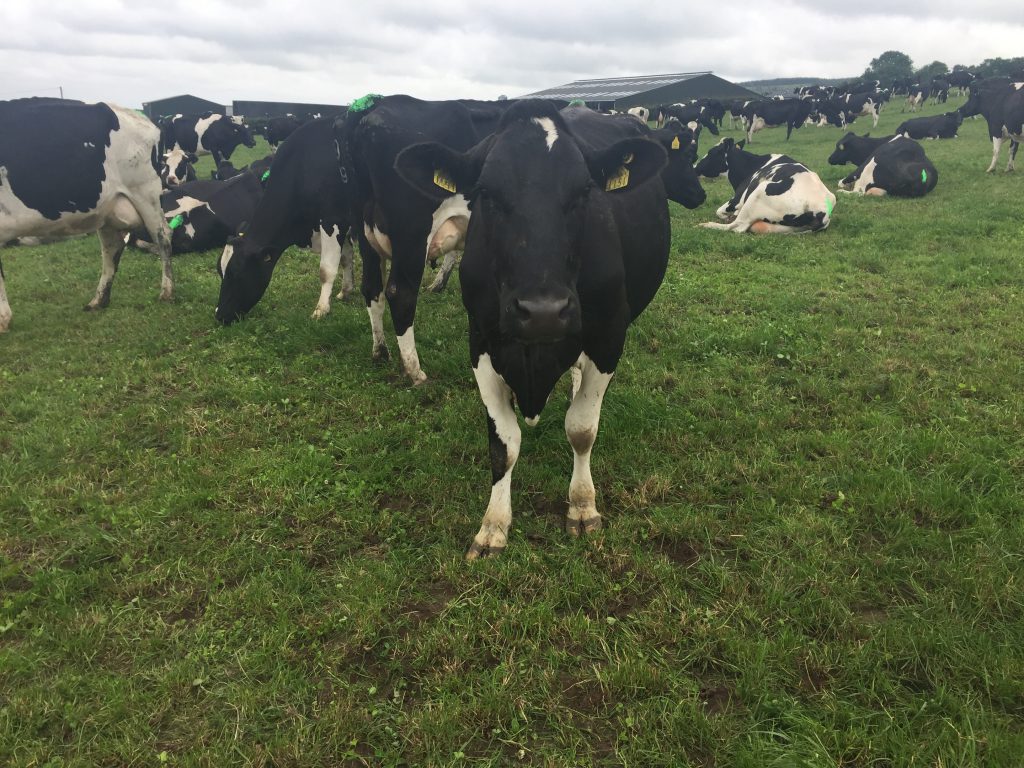Tom and Moya Power were crowned the overall winners of the National Dairy Council/Kerrygold National Milk Quality Award last October.
The Powers have been farming in the townland of Ballymullala, Cappagh, Co. Waterford for generations and their dairy enterprise has excelled, in terms of the quality of milk it produces, in recent years.
Tom, who farms with the assistance of his father Jim, opened the gates of the family’s farm to hundreds of visitors as part of the Teagasc national milk quality farm walk.
The Power’s herd
Tom and Jim currently milk a spring-calving herd of 234 black and white cows on a 90ha milking platform. This includes 67ha of owned land and 23ha of leased ground.
The Power’s herd comes from a traditional British Friesian base and, in recent years, high EBI sires have been used to breed herd replacements.
The heifers introduced to the herd this year have similar genetic merit for fertility to the herd average, but they have higher milk production potential.
In addition, approximately 50% of the 2017-born calves are sired by crossbred AI bulls.
Like many dairy farms throughout Ireland, the Powers have increased their cow numbers in a post-quota environment – moving from 202 cows in 2015 to 234 cows this year. As mentioned earlier, the Powers received national recognition in 2016 when they were crowned the overall winners of National Dairy Council/Kerrygold National Milk Quality Award.
This award is an important acknowledgement of the excellent husbandry skills of Irish milk producers. It also rewards excellence in Somatic Cell Count (SCC) levels, Total Bacterial Count (TBC) and Thermoduric readings in raw milk.
These are three areas that the Powers have paid a lot of attention to and Tom and Jim have produced milk with consistently low SCC and TBC levels in recent years.
Last year, they supplied over 1.2 million litres to Glanbia Ingredients Ireland. This milk had a SCC reading of 76,000 cells/ml, a 4,000 CFU/ml TBC content and a Thermoduric reading of 138.
The composition of the milk produced on the farm has also improved over a seven-year period. Last year 460kg of milk solids were sold from each cow in the herd (4.4% fat and 3.6% protein).
However, this hasn’t always been the case as the SCC varied from 121,000 cells/ml to 173,000 cells/ml between 2010 and 2014.
Tom admitted that he had been milk recording for years, but only realised there was a problem when two consecutive recordings produced SCC scores of over 400,000 cells/ml. “I was milk recording for 15 years, but I wasn’t paying close enough attention to the results. I wasn’t culling cows with high cell counts and we ran into trouble in 2007,” he said.
Any cow with a SCC reading of over 100,000 cells/ml is now regarded as a problem cow on the Powers’ farm.
To solve this issue, the Powers have introduced selective dry cow therapy and only the cows with an SCC reading of over 100,000 cells/ml are treated with antibiotics at dry off.
This meant that only 50% of the herd received antibiotic treatments last year, while teat sealants were used to protect the remainder of the herd.
Another unique programme the Powers have introduced is teat sealing of replacement heifers.
Last October, all of the in-calf replacement heifers in the herd were teat sealed using half a tube of sealant per teat.
This programme was introduced to solve problems with early lactation mastitis that were occurring in first-lactation cows in the herd. This programme has been used on the farm for the last three years and it has eliminated the problem.
Tom also gave the farmers in attendance a brief run-down of his journey into dairy farming, adding that he is the fifth generation of the Power family to farm the land in Ballymullala. “I was always attracted to farming and none of my siblings were interested in coming home to farm.
“I attended Rockwell College in 1996/1997 and afterwards the opportunity came up to travel to New Zealand to milk cows.
It was a great experience and it was the most valuable year of my life, because I got to see and learn how a large-scale dairy farm operates. “It gave me the opportunity to grow and take on responsibility – something that wasn’t available at home at the time,” he said.
On his return to Ireland, Tom and Jim entered into a partnership and the farm needed to provide an income for two families.
“We started to grow the herd organically from our own replacement heifers and through the quota purchase scheme,” he said.
While all of this was happening, Tom continued to remain focused on compact calving, grassland management, breeding and producing high-quality milk.
This focus has paid dividends for the Powers and the farm is now capable of supporting three full-time labour units. This includes Tom, Jim and Shane Flavin, a full-time employee.
Teagasc’s Eoin Power, a local dairy advisor, also discussed the farm finances.
In 2016, he said, the farm produced a net profit of €1,684/ha or €662/cow. When a value was placed on Tom and Jim’s own labour the profit stood at €721/ha or €290/cow.
Producing high-quality milk
Treating problem cows
Dairy farm – always an attractive career
Farm finances





